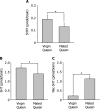Changes in the content of brain biogenic amine associated with early colony establishment in the Queen of the ant, Formica japonica
- PMID: 22905265
- PMCID: PMC3419698
- DOI: 10.1371/journal.pone.0043377
Changes in the content of brain biogenic amine associated with early colony establishment in the Queen of the ant, Formica japonica
Abstract
We examined changes in the content of biogenic amines in the brains of ant queen associated with early colony establishment. In ants, including Formica japonica, winged virgin queens lose their wings following copulation, and then start establishing a colony. Significant changes in brain biogenic amine content in the queen are associated with transition from winged virgin queen to wingless mated queen. The levels of serotonin (5HT), octopamine (OA) and dopamine (DA) decreased significantly in the brain of the queen after starting a colony. On the other hand, tyramine (TA) increased significantly in the brain following colony establishment. Catabolized substances of the biogenic amines in the brain were also measured. The levels of N-acetyloctopamine (Nac-OA) and N-acetyltyramine (Nac-TA) in the brain did not show a significant change after the queen established a colony. However, the levels of N-acetylserotonin (Nac-5HT) in the brain were significantly higher in wingless mated queens than in winged virgin queens, whereas levels of N-acetyldopamine (Nac-DA) in the brain were significantly lower in wingless mated queens than winged virgin queens. These results suggest that serotonergic and octopaminergic systems in the brain of the queen change when the mated queen starts to establish a new colony.
Conflict of interest statement
Figures




Similar articles
-
Queen regulates biogenic amine level and nestmate recognition in workers of the fire ant, Solenopsis invicta.Naturwissenschaften. 2008 Dec;95(12):1155-8. doi: 10.1007/s00114-008-0432-6. Epub 2008 Aug 13. Naturwissenschaften. 2008. PMID: 18704354
-
Octopaminergic system in the brain controls aggressive motivation in the ant, Formica japonica.Acta Biol Hung. 2012;63 Suppl 2:63-8. doi: 10.1556/ABiol.63.2012.Suppl.2.6. Acta Biol Hung. 2012. PMID: 22776474
-
Social interactions influence dopamine and octopamine homeostasis in the brain of the ant Formica japonica.J Exp Biol. 2011 May 15;214(Pt 10):1707-13. doi: 10.1242/jeb.051565. J Exp Biol. 2011. PMID: 21525317
-
Lesion of selected brain areas as a tool for the demonstration of some trace biogenic amines neural pathways.Gen Pharmacol. 1987;18(1):1-5. doi: 10.1016/0306-3623(87)90159-5. Gen Pharmacol. 1987. PMID: 3104130 Review. No abstract available.
-
Biogenic amine receptors in parasitic nematodes: what can be learned from Caenorhabditis elegans?Mol Biochem Parasitol. 2004 Sep;137(1):1-11. doi: 10.1016/j.molbiopara.2004.05.010. Mol Biochem Parasitol. 2004. PMID: 15279946 Review.
Cited by
-
Relationship between the grades of a learned aversive-feeding response and the dopamine contents in Lymnaea.Biol Open. 2016 Dec 15;5(12):1869-1873. doi: 10.1242/bio.021634. Biol Open. 2016. PMID: 27815244 Free PMC article.
-
Tyraminergic modulation of agonistic outcomes in crayfish.J Comp Physiol A Neuroethol Sens Neural Behav Physiol. 2018 May;204(5):465-473. doi: 10.1007/s00359-018-1255-3. Epub 2018 Feb 27. J Comp Physiol A Neuroethol Sens Neural Behav Physiol. 2018. PMID: 29488014
-
Exposure to static electric fields leads to changes in biogenic amine levels in the brains of Drosophila.Proc Biol Sci. 2015 Aug 7;282(1812):20151198. doi: 10.1098/rspb.2015.1198. Proc Biol Sci. 2015. PMID: 26224706 Free PMC article.
-
Chemical cognition: chemoconnectomics and convergent evolution of integrative systems in animals.Anim Cogn. 2023 Nov;26(6):1851-1864. doi: 10.1007/s10071-023-01833-7. Epub 2023 Nov 28. Anim Cogn. 2023. PMID: 38015282 Free PMC article.
-
Using machine learning to predict protein-protein interactions between a zombie ant fungus and its carpenter ant host.Sci Rep. 2023 Aug 24;13(1):13821. doi: 10.1038/s41598-023-40764-8. Sci Rep. 2023. PMID: 37620441 Free PMC article.
References
-
- Kondoh M (1968) Bioeconomic studies on the colony of an ant species Formica japonica Motschulsky. 1. Nest structure and seasonal change of the colony members. Jpn J Ecol 18: 124–133.
-
- Masuko K, Murakami M, Matsumoto T (1998) Polygyny and monoandry in the ant Formica japonica (Hymenoptera: Formicidae). Zool Sci 15: 409–414. - PubMed
-
- Buschinger A (1974) Monogynie und Polygyny in Insektensozietäten. In Sozialpolymorphismus bei Insekten. Ed. Scmidt GH, Wissenschafteliche Verlagsgesellschaft, Stuttgart.
-
- Obara Y, Fukano Y, Watanabe K, Ozawa G Sasaki K (2011) Serotonin-induced mate rejection in the female cabbage butterfly, Pieris rapae crucivora. Naturwissenschaften 98: 989–993. - PubMed
Publication types
MeSH terms
Substances
LinkOut - more resources
Full Text Sources

